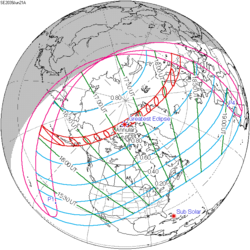| Total eclipse | |
| Gamma | 0.3727 |
|---|---|
| Magnitude | 1.032 |
| Maximum eclipse | |
| Duration | 174 s (2 min 54 s) |
| Coordinates | 29°06′N158°00′E / 29.1°N 158°E |
| Max. width of band | 116 km (72 mi) |
| Times (UTC) | |
| Greatest eclipse | 1:56:46 |
| References | |
| Saros | 145 (23 of 77) |
| Catalog # (SE5000) | 9586 |
A total solar eclipse will occur at the Moon's ascending node of orbit on Sunday, September 2, 2035, [1] with a magnitude of 1.032. A solar eclipse occurs when the Moon passes between Earth and the Sun, thereby totally or partly obscuring the image of the Sun for a viewer on Earth. A total solar eclipse occurs when the Moon's apparent diameter is larger than the Sun's, blocking all direct sunlight, turning day into darkness. Totality occurs in a narrow path across Earth's surface, with the partial solar eclipse visible over a surrounding region thousands of kilometres wide. Occurring about 2.9 days after perigee (on Thursday, August 30, 2035, at 3:35 UTC), the Moon's apparent diameter will be larger. [2]
Contents
- Visibility
- Eclipse timing
- Places experiencing total eclipse
- Places experiencing partial eclipse
- In popular culture
- Eclipse details
- Eclipse season
- Related eclipses
- Eclipses in 2035
- Metonic
- Tzolkinex
- Half-Saros
- Tritos
- Solar Saros 145
- Inex
- Triad
- Solar eclipses of 2033–2036
- Saros 145
- Metonic series
- Tritos series
- Inex series
- Notes
- References
- External links
Totality will be visible from parts of northern China, North Korea, the extreme northern tip of South Korea (Goseong County, Gangwon Province) and Japan. A partial eclipse will be visible for most of Asia, northern Oceania, Hawaii, southwest Alaska, and the western United States.








































































































